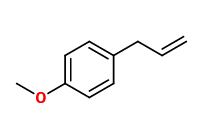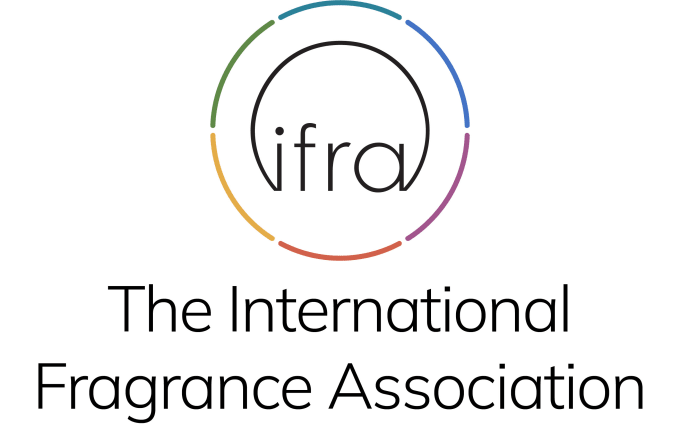
Photo credits: ScenTree SAS
Estragole
4-allyl anisole ; Para-allyl anisole ; Para-allyl methoxybenzene ; 4-allyl methoxybenzene ; 1-allyl-4-methoxybenzol ; 4-allylphenyl methyl ether ; Isoanethole ; Méthyl chavicol ; Chavicol methyl ether ; Esdragol ; 1-methoxy-4-(2-propen-1-yl)-benzene ; Para-methoxyallyl benzene

Photo credits: ScenTree SAS
Do you sell any of the raw materials? Would you like to let our users know?
Send an email to fournisseurs@scentree.coto learn about our advertising opportunities.
Do you sell any of the raw materials? Would you like to let our users know?
Send an email to fournisseurs@scentree.coto learn about our advertising opportunities.
General Presentation
-
CAS N° : 140-67-0
-
EINECS number : 205-427-8
-
FEMA number : 2411
-
FLAVIS number : Donnée indisponible.
-
JECFA number : 1789
-
Appearance : Colorless liquid
-
Density : 0,96
-
Volatility : Head
-
Price Range : €
Physico-chemical properties
-
Molecular formula : C10H12O
-
Molecular Weight : 148,22 g/mol
-
Log P : Donnée indisponible.
-
Fusion Point : Donnée indisponible.
-
Boiling Point : 216°C
-
Detection Threshold : Donnée indisponible.
-
Optical rotation : Donnée indisponible
-
Vapor pressure : Donnée indisponible
-
Refractive Index @20°C : Donnée indisponible
-
Acid Value : Donnée indisponible.
-
Flash Point : 82°C
Uses
Uses in perfumery :
Estragole brings an anisic and green facet in a composition. It is overall used in masculine fragrances in low quantity to bring a sweet effect, while Anethole is even sweeter. Estragole is also used due to its low cost.
Year of discovery :
Data not available.
Natural availability :
Estragole is found in nature in some essential oils : Tarragon EO, Basil (Estragol chemotype) EO and Turpentine EO for example. It can be extracted from them by distillation.
Isomerism :
Estragole is a positional isomer of Anethole. The carbon double bond of these molecules is not at the same place. They have a very similar smell. Anethole remains anyway a very neutral anisic note, and has a less green and aromatic character.
Synthesis precursor :
Estragole is not used for the synthesis of another compound use din perfumery.
Synthesis route :
In most cases, Estragole is not synthesized. It is extracted from essential oils as Tuprentine EO, having a very low cost. Then, a distillation of this oil ables to recover Estragole. Another way to get it strating with this oil is to treat it in petroleum ether, with an aqueous solution of mercury acetate, followed by heating the aqueous phase with zinc and sodium hydroxyde. This is a more costly way of obtaining Estragole, but with a better yield.
Regulations & IFRA
Allergens :
This ingredient does not contain any allergen.
IFRA 51th :
This ingredient is restricted by the 51th amendment
- Quantitative limit on the use :
-
Cat.1 Cat.2 Cat.3 Cat.4 Cat.5A B C DCat.6 0,00031 % 0,0025 % 0,00063 % 0,014 % 0,0022 % 0,00063 % 0,00063 % 0,00021 %0,0019 % Cat.5A B C DCat.6 0,0022 % 0,00063 % 0,00063 % 0,00021 %0,0019 % Cat.7A BCat.8 Cat.9 Cat.10A BCat.11A BCat.12 0,00063 % 0,00063 %0,00021 % 0,0041 % 0,00094 % 0,0022 %0,00021 % 0,00021 %0,11 % Cat.10A BCat.11A BCat.12 0,00094 % 0,0022 %0,00021 % 0,00021 %0,11 %
Annexe I :
Some regulated synthetic ingredients are found in nature and in certain proportions in natural ingredients. This presence in nature has to be taken into account when calculating limits of use recommended by the IFRA. In case you do not know these concentrations, you can use the ones estimated by the IFRA. Here they are :
| List of regulated compounds contained in this ingredient | |||
|---|---|---|---|
| Ingredient Name | Botanical Name | CAS N° | Estimated Concentration |
| Anise seed oil | Pimpinella anisum L. | 8007-70-3 | 2,39 |
| Star anise oil | Illicium verum Hook, f. | 68952-43-2 | 3,3 |
| Basil oil, chemotype estragole | Ocimum basilicum L. | 8015-73-4 | 81,87 |
| Basil oil, chemotype linalool | Ocimum basilicum L. | 8015-73-4 | 0,95 |
| Basil oleoresin, chemotype estragole | Ocimum basilicum L. | 8015-73-4 | 34 |
| Bay leaf, West Indian, oil | Pimenta racemosa (Mill.) J.W. Moore | 8006-78-8 | 0,1 |
| Tarragon oil | Artemisia dracunculus L. | 8016-88-4 | 80 |
| Fennel oil, bitter,anethole type | Foeniculum vulgare Mill. | 8006-84-6 | 2,1 |
| Fennel oil, sweet | Foeniculum vulgare subsp. vulgare var. Dulce (Mill) Batt. | 8006-84-6 | 2,32 |
| Fir needle oil, Canadian | Abies balsamea (L.) Mill. | 8024-15-5 | 0,04 |
| Hyssop oil | Hyssopus officinalis L. | 8006-83-5 | 0,17 |
| Laurel leaf oil | Laurus nobilis L | 8007-48-5 | 0,16 |
| Mentha citrata oil | Mentha citrata Ehrhart | 68917-15-7 | 0,3 |
| Myrtle oil | Myrtus communis L. | 8008-46-6 | 0,1 |
| Ylang ylang oil I | Cananga odorata (Lam.) Hook. f. &Thomson oil (forma genuine Steenis) | 8006-81-3 | 0,2 |
| Ylang ylang oil II | Cananga odorata (Lam.) Hook.f.&Thomson forma genuina | 8006-81-3 | 0,13 |
| Ylang ylang oil III | Cananga odorata (Lam.) Hook. f. &Thomson oil (forma genuine Steenis) | 8006-81-3 | 0,03 |
| Ylang, Ylang oil extra | Cananga odorata (Lam.) Hook. f. &Thomson oil (forma genuine Steenis) | 8006-81-3 | 0,02 |
| Fennel oil, bitter, phellandrene type | Foeniculum vulgare Mill. | 84625-39-8 | 4,7 |
| Ravensara aromatica oil | Ravansara aromatica Sonn. (v. anisata) | 91770-56-8 | 8 |



